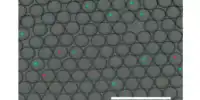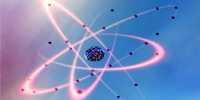The electron is the fundamental unit of electricity, carrying a single negative charge. This is what we’re taught in high school physics, and it applies to the vast majority of natural materials.
However, in particularly rare states of matter, electrons can splinter into fractions of their original size. This phenomenon, known as “fractional charge,” is extremely unusual, and if it can be harnessed and managed, the exotic electronic state could aid in the development of robust, fault-tolerant quantum computers.
This process, known to physicists as the “fractional quantum Hall effect,” has only been witnessed a few times, and usually at extremely strong, precisely controlled magnetic fields. Scientists have only recently observed the phenomenon in a material that does not require as strong magnetic manipulation.
MIT physicists have discovered the elusive fractional charge phenomenon, this time in a simpler material: five layers of graphene, an atom-thin layer of carbon derived from graphite, and common pencil lead. They publish their findings in Nature.
They discovered that stacking five sheets of graphene-like steps on a stairway creates the ideal conditions for electrons to travel through as fractions of their total charge, without the requirement for an external magnetic field.
The findings provide the first proof of the “fractional quantum anomalous Hall effect” (the term “anomalous” refers to the lack of a magnetic field) in crystalline graphene, a material that scientists did not expect to exhibit this effect.
“This five-layer graphene is a material system where many good surprises happen,” says study author Long Ju, an MIT assistant professor of physics. “Fractional charge is such an exotic phenomena, and we can now achieve it with a lot simpler apparatus and no magnetic field. That in itself is significant for fundamental physics. And it may pave the way for quantum computing that is more resistant to disruption.”
Ju’s MIT co-authors include lead author Zhengguang Lu, Tonghang Han, Yuxuan Yao, Aidan Reddy, Jixiang Yang, Junseok Seo, and Liang Fu, as well as Kenji Watanabe and Takashi Taniguchi from Japan’s National Institute for Materials Science.
A bizarre state
The fractional quantum Hall effect is one example of the strange events that can occur when particles transition from acting as individual units to acting as a group. This collective “correlated” activity develops in unique conditions, such as when electrons are slowed from their normally fast rate to a crawl, allowing the particles to detect and interact with one another. These interactions can result in rare electronic states, such as the seemingly unusual splitting of an electron’s charge.
In 1982, scientists discovered the fractional quantum Hall effect in gallium arsenide heterostructures, which occurs when a gas of electrons contained in a two-dimensional plane is exposed to high magnetic fields. The discovery later earned the group the Nobel Prize in Physics.
“[The discovery] was a very big deal, because these unit charges interacting in a way to give something like fractional charge was very, very bizarre,” Ju said. “At the time, there were no theory predictions, and the experiments surprised everyone.”
The researchers accomplished their ground-breaking discoveries by utilizing magnetic fields to slow down the electrons of the material enough for them to interact. The fields they worked with were roughly ten times stronger than what ordinarily powers an MRI machine.
In August 2023, scientists at the University of Washington revealed the first evidence of fractional charge in the absence of a magnetic field. They detected an “anomalous” version of the phenomenon in a twisted semiconductor known as molybdenum ditelluride. The researchers produced the material in a precise configuration, which theorists anticipated would result in an inherent magnetic field strong enough to stimulate electron fractionalization without external magnetic control.
The “no magnets” result paved the way for topological quantum computing, a more secure form of quantum computing in which the addition of topology (a property that remains unchanged in the face of weak deformation or disturbance) provides an extra layer of protection to a qubit during computation.
This computation method is based on the fractional quantum Hall effect and a superconductor. It used to be nearly hard to realize: fractional charge requires a powerful magnetic field, but the same magnetic field typically kills the superconductor. In this situation, the fractional charges would function as qubits (the fundamental unit of a quantum computer).
Making steps:
That same month, Ju and his team discovered hints of anomalous fractional charge in graphene, a material with no previous predictions for such a phenomenon.
Ju’s group has been studying electronic behavior in graphene, which possesses unique features. Ju’s group has lately investigated pentalayer graphene, which is a structure made up of five graphene sheets placed slightly apart from one another, similar to staircase steps.
This pentalayer graphene structure is embedded in graphite and can be created through exfoliation with Scotch tape. When placed in a refrigerator at ultracold temperatures, the structure’s electrons slow down and interact in ways they wouldn’t at warmer temperatures.
In their new study, the researchers conducted calculations and discovered that electrons could interact even more strongly if the pentalayer structure was aligned with hexagonal boron nitride (hBN), a material with a similar atomic structure to graphene but slightly different dimensions.
When the two materials combine, they should form a moiré superlattice, which is an intricate, scaffold-like atomic structure that can delay electrons in ways similar to a magnetic field.
“We did these calculations, then thought, let’s go for it,” says Ju, who happened to construct a new dilution refrigerator in his MIT lab last summer, which the team intended to use to cool materials down to ultra-low temperatures to research exotic electronic behavior.
The researchers created two samples of the hybrid graphene structure by first exfoliating graphene layers off a block of graphite and then using optical techniques to locate five-layered flakes in the steplike shape. They then stamped the graphene flake onto a hBN flake before covering it with another hBN flake. Finally, they affixed electrodes to the structure and stored it in a refrigerator set at near absolute zero.
As scientists applied current to the material and evaluated the voltage output, they noticed fractional charge signatures, which occur when the voltage equals the current multiplied by a fractional number plus several fundamental physics constants.
“The day we saw it, we didn’t recognize it at first,” explains first author Lu. “Then we started shouting because we realized how massive this was. It was an unexpected occasion.
“This was probably the first serious samples we put in the new fridge,” says co-first author Han. “Once we calmed down, we looked in detail to make sure that what we were seeing was real.”
Following additional study, the scientists determined that the graphene structure did indeed exhibit the fractional quantum anomalous Hall effect. This is the first time the phenomenon has been observed in graphene.
“Graphene can also be a superconductor,” Ju said. “So you could have two completely distinct effects in the same material, right next to one another. Using graphene to communicate with graphene prevents many undesirable effects when bridging graphene with other materials.”
For the time being, the researchers are still investigating multilayer graphene for additional uncommon electronic states.
“We are diving in to explore many fundamental physics ideas and applications,” he said. “We know there will be more to come.”















